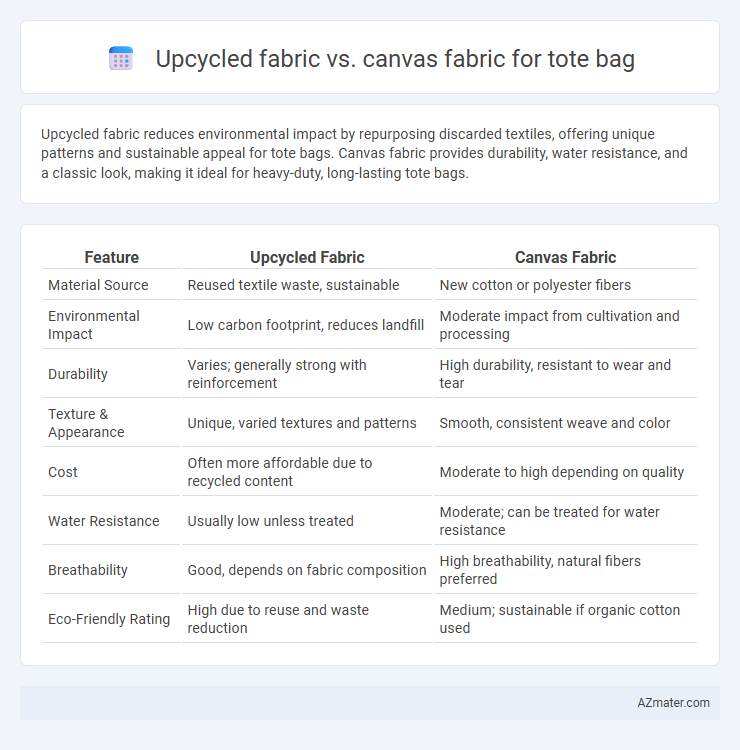Upcycled fabric reduces environmental impact by repurposing discarded textiles, offering unique patterns and sustainable appeal for tote bags. Canvas fabric provides durability, water resistance, and a classic look, making it ideal for heavy-duty, long-lasting tote bags.
Table of Comparison
| Feature | Upcycled Fabric | Canvas Fabric |
|---|---|---|
| Material Source | Reused textile waste, sustainable | New cotton or polyester fibers |
| Environmental Impact | Low carbon footprint, reduces landfill | Moderate impact from cultivation and processing |
| Durability | Varies; generally strong with reinforcement | High durability, resistant to wear and tear |
| Texture & Appearance | Unique, varied textures and patterns | Smooth, consistent weave and color |
| Cost | Often more affordable due to recycled content | Moderate to high depending on quality |
| Water Resistance | Usually low unless treated | Moderate; can be treated for water resistance |
| Breathability | Good, depends on fabric composition | High breathability, natural fibers preferred |
| Eco-Friendly Rating | High due to reuse and waste reduction | Medium; sustainable if organic cotton used |
Introduction to Tote Bag Fabrics
Upcycled fabric and canvas fabric are popular choices for tote bags, each offering distinct advantages in sustainability and durability. Upcycled fabric repurposes existing materials, reducing waste and environmental impact, while canvas fabric is a sturdy, woven material typically made from cotton or linen, known for its strength and longevity. Selecting between these fabrics depends on prioritizing eco-friendliness with upcycled options or classic durability with canvas.
What is Upcycled Fabric?
Upcycled fabric refers to textile materials repurposed from pre-existing garments or scraps, reducing waste by giving new life to otherwise discarded fabrics. This eco-friendly choice promotes sustainability and unique, one-of-a-kind designs for tote bags. Canvas fabric, in contrast, is a sturdy, woven textile made primarily from cotton or linen, known for its durability and heavy-duty usage.
What is Canvas Fabric?
Canvas fabric is a heavy-duty, plain-woven textile typically made from cotton or linen, renowned for its durability and sturdiness in tote bag construction. It offers excellent resistance to wear and tear, making it ideal for carrying heavy items and daily use. Compared to upcycled fabric, canvas provides a consistently strong and long-lasting material with superior structural integrity.
Sustainability Comparison: Upcycled vs Canvas
Upcycled fabric for tote bags significantly reduces textile waste by repurposing existing materials, lowering the demand for new resource-intensive production. Canvas fabric, often made from cotton, requires extensive water, pesticides, and energy during cultivation and processing, impacting its environmental footprint. Choosing upcycled fabric enhances sustainability by minimizing landfill contributions and conserving raw materials compared to traditional canvas.
Durability and Longevity
Upcycled fabric for tote bags offers unique sustainability benefits but generally has lower durability compared to canvas fabric, which is renowned for its strength and resilience. Canvas fabric, typically made from tightly woven cotton or linen, withstands heavy use, resists tearing, and maintains its structural integrity over time. The longevity of canvas tote bags often surpasses that of upcycled fabric counterparts, making canvas a preferred choice for long-lasting, durable bags.
Style and Aesthetic Appeal
Upcycled fabric tote bags offer unique, one-of-a-kind style with varied patterns and textures that reflect sustainable fashion trends. Canvas fabric provides a classic, durable aesthetic with a clean, minimalistic look favored for versatility and timeless appeal. Both materials enhance tote bag design, but upcycled fabric appeals to eco-conscious consumers seeking distinctiveness, while canvas suits those preferring functional simplicity.
Cost Considerations
Upcycled fabric for tote bags generally offers lower costs due to the reuse of existing materials, reducing raw material expenses and waste management fees. Canvas fabric, while more expensive, provides durability and uniform quality that can justify higher retail prices and appeal to consumers seeking longevity. Budget-conscious producers often choose upcycled fabric to minimize production costs and promote sustainability without compromising basic functionality.
Environmental Impact
Upcycled fabric significantly reduces environmental impact by repurposing existing textiles, thereby minimizing waste and lowering carbon emissions associated with new fabric production. Canvas fabric, often made from cotton, requires intensive water usage and pesticide application during cultivation, contributing to higher ecological footprints. Choosing upcycled materials for tote bags supports sustainable fashion by conserving resources and promoting circular economy principles.
Use Cases: When to Choose Upcycled or Canvas
Upcycled fabric is ideal for eco-conscious consumers seeking unique, sustainable tote bags perfect for casual outings and light errands. Canvas fabric, known for its durability and water resistance, suits heavy-duty use such as grocery shopping, carrying books, or outdoor activities. Choose upcycled fabric to emphasize environmental impact and individuality, while canvas is better for reliability and long-term wear.
Final Verdict: Which Fabric Wins for Tote Bags?
Upcycled fabric excels in sustainability and unique aesthetics, making each tote bag eco-friendly and visually distinct, while canvas fabric offers superior durability, water resistance, and long-term strength ideal for heavy use. Canvas totes withstand wear and tear better, maintaining structure and support for daily carrying needs, whereas upcycled fabric emphasizes environmental impact and individuality. For long-lasting, practical tote bags, canvas fabric wins, but for environmentally conscious, one-of-a-kind designs, upcycled fabric remains a strong contender.

Infographic: Upcycled fabric vs Canvas fabric for Tote bag
 azmater.com
azmater.com